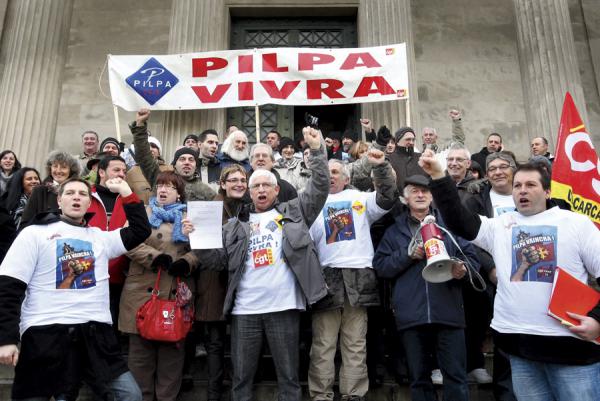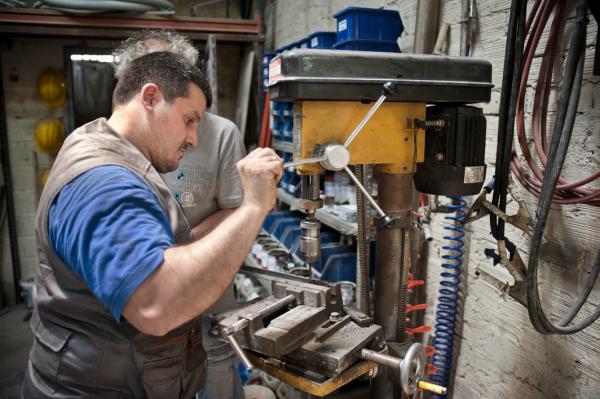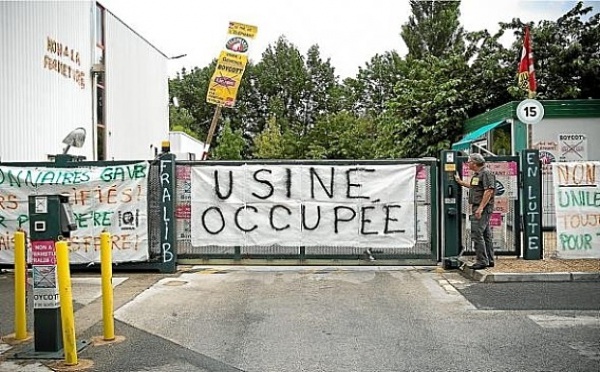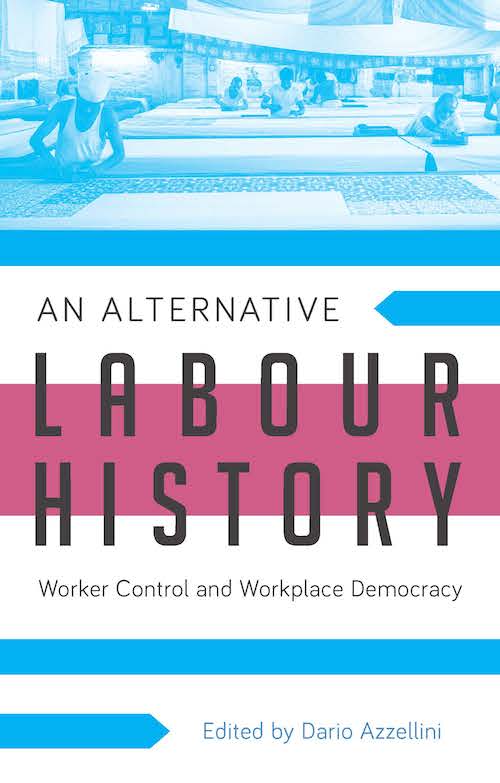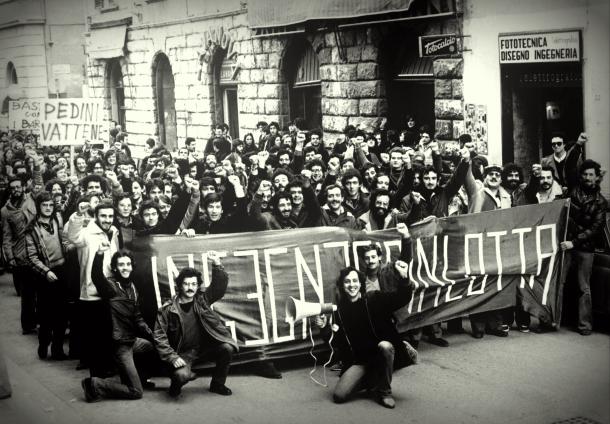The demand for workers’ control of the factories is at the center of the “democratic and peaceful road” to socialism. The following theses mean to provide an initial, provisional direction for a wide debate that gathers not only the contributions of politicians and specialists but also and above all the experience of the workers’ movement, which are the only conclusive verification of the elaboration of socialist thought.
1. On the question of the transition from capitalism to socialism
In the workers’ movement there has been for a long time, and in successive periods, a discussion of the question of the modes and temporalities of the transition to socialism. One tendency, which occurred in various forms, believed it was possible to schematize the temporality of this process, as if socialist construction had to be preceded, always and in every case, by the “phase” of construction of bourgeois democracy. In this way the proletariat, where the bourgeoisie has not yet completed its revolution, would come to be assigned the task of conducting its struggle with a delimited end in view: that indeed of constructing or favoring the construction of modes of production and of political forms of a completed bourgeois society. This conception can be defined schematically because it claims to apply in the abstract and without reference to a historical reality, a prefabricated model. If in fact it is true that the reality of political Institutions corresponds, in every epoch, to the economic reality, it is however an error to believe that the economic reality (productive forces and relations of production) develops according to a line that is always gradual, regular, perfectly predictable because divided in precise successive phases, one distinct from the other. It is sufficient, to understand the nature of this error, to reflect on some historical examples. When, at the beginning of the last century, technical progress (invention of the mechanical loom and the steam engine) brought about a qualitative leap in production (industrial revolution) which remained in force, the old forms of production [remained] alongside the new; and in the more economically evolved countries the political struggle had therefore a rather complex character. On one side there was the resistance to the feudal survivals, on the other side the affirmation of the industrial bourgeoisie; and finally, at the same time, the appearance of a new class, the industrial proletariat. In Russia, at the end of the first revolutionary wave (February 1917), after the collapse of the Tsarist autocracy and the monstrous capitalist-feudal system, one part of the Marxist workers’ movement, falling into the same error, maintained that the Russian proletariat had to join forces with the bourgeoisie to realize the necessary “second stage” (bourgeois democracy) of the revolution. As is known, this thesis was defeated by Lenin and the majority of the Russian workers’ movement; in the total collapse of the old system the only real protagonist remained the proletariat, and its problem was not therefore that of creating the typical institutions of the bourgeoisie, but of constructing the institutions of its democracy, of socialist democracy. In China between 1924 and 1928, there was the prevalence in the communist party of those who erroneously wanted to commit the class movement to unconditionally supporting the Kuomintang of Chiang Kai-shek, helping it to realize, after the collapse of the Manchu dynasty and the feudal system, the second stage (bourgeois democracy): they did not account for the inexistence of a Chinese bourgeoisie capable of establishing itself as a “national” class, or for the fact that the immense masses of peasants of this country could struggle only for the cause of their own emancipation, and not in pursuit of abstract and incomprehensible schemes.
These considerations do not lead by any means to exalting an intellectualist revolutionary voluntarism (to affirming, that is, that the revolution can be the fruit of an act of will of a vanguard group), but only to clarifying as, first of all, every political force, rather than chasing prefabricated models, must become aware of its own reality, the always complex and specific field within which it moves. It is social democracy in all its forms which, to cover up its opportunism and justify it ideologically, systematically mixes up the cards on the table and reduces every position consistent with the revolutionary left to that of an intellectualist voluntarism. The historical essence of the social-democratic experience consists moreover in this: in the assigning, with the pretext of the struggle against maximalism, to the proletariat the task of supporting the bourgeoisie or even of replacing it in the construction of bourgeois democracy: and by that very fact it denies the tasks and the revolutionary autonomy of the proletariat, and finishes by assigning to it the position of a subaltern force.
In today’s Italian society the fundamental factor is constituted by the fact that the bourgeoisie has never been, is not, can never be a “national” class; a class thus capable (as happened in England and France) of guaranteeing, albeit in a certain period of time, the development of national society, in its whole. The Italian bourgeoisie arose on a corporate and parasitical basis, namely:
- through the formation of individual industrial sectors that did not constitute a national market, but survived on the exploitation of a market of a quasi-colonial kind (the South)
- by means of the permanent recourse to the protection and active support of the State
- with the alliance with the remains of feudalism (agrarian bloc of the South)
Fascism was the inflamed expression of this contradictory equilibrium, and of the domination, in this form, of the bourgeoisie: it, also through the massive intervention of the totalitarian State in favor of bankrupt private industry (IRI) [Istituto per la Ricostruzione Industriale, fascist bailout in 1933], promoted to the maximum the transformation of determinate industrial sectors into powerful monopolistic structures (Fiat, Montecatini, Edison, etc.). After the collapse of fascism the monopolies found, in the intensification of the relations with American big industry and in the subordination to it, the continuation of their old anti-national policy (Italian big industry is always, in one way or another, cartelized with big international monopolies; one of the cases in which these links have appeared with great evidence was when Fiat, Edison, and Montecatini supported in Italy the campaign for the international oil cartel; and in general the Atlanticism of the parties of the center-right is the expression of links of subordination that we have indicated. The Marshall Plan, expression of American imperialism, was accepted by Italian monopolies before the political parties). Thus is established a situation in which next to the monopolistic areas there coexist large areas of deep depression and backwardness, (many zones in the mountains and hills, the Po delta and, more generally, the South and the islands); the distance between social stratum and social stratum [ceto sociale], between region and region, increases enormously; the traditional imbalances of industrial production grow; the monopolistic bottlenecks tighten (the limitations and distortions, that is, that the power and politics of monopolies oppose the full and balanced development of the productive forces); there is mass unemployment that becomes a permanent element of our economy; the traditional terms of the greatest problem of our socioeconomic structure (the Southern question) are reproduced in an aggravated fashion.
However, it would be a great error to reaffirm the existence of these facts to conceal, as has been done in recent years, the new elements. There is no doubt that, starting above all with 1951-52, in some sectors Italian capitalism was able to take advantage of the favorable international conjuncture and the considerable economic progress: there was thus a phase of expansion (rapid growth of production, growth of income, rapid accumulation of capital and intense boost in fixed capital) that nevertheless, unfolding under the control of the monopolies, remained restricted to their area, and even provoked the aggravation of the fundamental imbalances of the Italian economy.
The contradictory situation, dominated by large areas of depression and the crisis we have described, is not going to improve but worsen, whether because of a possible reversal of the international conjuncture, or a probable growth of technological unemployment, or the negative effects of the Common Market, or finally because the characteristics of the internal Italian market (its narrow-mindedness, its poverty) don’t provide an adequate area to merge with productive capacity and technological maturity, which is further maturing in the monopolistic area.
An analysis of this type does not aim and does not serve naturally to valorize the prospect of a “catastrophic” crisis of capitalism; and moreover a polemic on the terrain of prophecies, and in these terms, would serve only to paralyze and sterilize the action of the class movement. What follows from this analysis is the existence of certain real conditions and the identification of the tendency of development implicit in them; and the conclusion that within the boundaries of these conditions and of this tendency the workers’ movement must act.
In light of these considerations the following theses appear therefore quite abstract and unreal (specifically today in Italy): a) the class movement must substantially limit itself to giving support to the capitalist class (or determinate bourgeois groups) in the construction of a regime of completed bourgeois democracy; b) the class movement must essentially substitute itself for the capitalist class and assume in its own right the task of constructing a regime of completed bourgeois democracy.
Instead the contradictions that sharply tear apart Italian society, the weight that the monopolies have acquired and continually tend more to assume, the contradictions between technological development and the capitalist relations of production, the weakness of the bourgeoisie as a national class, lead the workers’ movement to take on tasks of a different nature; to struggle at the same time for reforms with a bourgeois content and for reforms with a socialist content. On the political level this signifies that the leading force of democratic development in Italy is the working class and under its direction can be realized the only efficient system of alliance, with the intellectuals, with the peasants, with the groups of small and medium bourgeois producers. It is this system of alliances and this kind of leadership that correspond to the real perspective.
2. The democratic road to socialism is the road of workers’ democracy.
It is a false deduction, which emerges from a wrong analysis of the Italian situation, and from a simplistic interpretation of the turning point registered in the theses proclaimed at the 20th conference of the CPSU, to affirm that the Italian road to socialism, democratic and peaceful, coincides with a “parliamentary” road to socialism. The affirmation of the democratic character of socialism is in fact correct, in the sense that it refutes all the old conceptions according to which the transition to socialism is an act of revolutionary voluntarism, and the work of an isolated minority, without the political and economic conditions having matured; it just as much rejects the conception that ties the the transition to socialism to the automatic verification of the “crash” of capitalism. But the democratic road cannot be reduced to an always and necessarily peaceful road, as in the moment when [dal momento che], including in a determinate Country when the conditions for socialism are mature and its forces have attained the majority of the votes, the resistance of the capitalist class and its recourse to violence nevertheless lead to an armed assault, and to the necessity of proletarian violence.
Nevertheless, in Italy today there is a democratic and peaceful perspective for socialism. But those who identify the exclusive (or even just the only significant or characteristic) instrument of the peaceful transition to socialism in Parliament, empty the very notion of the democratic and peaceful road of any real substance. In this way they revive instead the old bourgeois mystifications that present the bourgeois representative State not as it is, as a class State, but as a State above classes; where the Parliament is only the place for the ratification and registration of the relations of force between classes, which develop and are determined outside of it, and the economy remains the sphere in which real relations are produced and is the real source of power.
It is right on the other hand to affirm that the use of the parliamentary institutions is also one of most important tasks laid out for the class movement, and that these very institutions can be transformed (by the pressure exercised from below by the workers’ movement through its new institutions) from the representative seat of merely political, formal leadership, to the expression of substantial political and economic rights at the same time.
3. The proletariat educates itself by constructing its own institutions.
When, in general, the road to socialism is defined as democratic, with the hope of fully guaranteeing the prospects of peaceful transition, the following concept is accordingly and in substance affirmed: that there is continuity in the methods of political struggle before, during, and after the revolutionary leap, and that therefore the institutions of proletarian power must form themselves not only after the revolutionary leap, but in the very course of the whole struggle of the workers’ movement for power. These institutions must arise from the economic sphere, where there is the real source of power, and represent therefore man not only as as citizen but also as producer: and the rights that are determined in these institutions must be political and economic rights at the same time. The real force of the class movement measures itself form the share of power and the capacity to exercise a leading function within the structure of production. The distance that separates the institutions of bourgeois democracy from the institutions of workers’ democracy is qualitatively the same as that which separates bourgeois society divided into classes from socialist society without classes. It is also to ward off the conception, of naive Enlightenment origins, that wants to generically “train” the proletariat for power, disregarding the concrete construction of its institutions. Thus we hear of the “subjective preparation” of the proletariat, of the “education” of the proletariat (and whose turn is it to play the role of educator?); but everybody knows that only those who jump in water learn how to swim (and for this reason, among others, it is best to start by throwing the Enlightened “educator” in the water).
Certainly these things aren’t new. They are the historical experience of the workers’ movement and of Marxism, from the Soviet of 1917 to the Turin movement of factory councils, to the Polish and Yugoslav workers’ councils, to the necessary discussion of the theses of the 20th Congress, that are going to take flesh before our eyes. It is all the more superfluous to have to recall that it is exactly on this issue, in the last years, that the Socialist Party has provided the most original contributions to the entire Italian workers’ movement.
4. On the current conditions of workers’ control.
Today the demand for workers’ control (workers and technicians) is not laid out only in relation with the reasons that have just been explained, but is connected to a series of new conditions which render this demand deeply contemporary and place it at the center of the struggle of the class movement:
- The first of these conditions is constituted by the development of the modern factory. On this terrain arises the practice and the ideology of the contemporary monopoly (human relations, scientific organization of labor, etc.), which aims at subordinating in an integral way spirit and body – the laborer to his boss, reducing him to a small cog in the gears of a large machine whose complexity remains unknown to him. The only way of breaking this process of total subjection of the person of the laborer is, aside from the laborer himself, that of first of all becoming conscious of the situation as it is in productive business terms; and to oppose to “business democracy” in the boss’s brand name, and to the mystification of “human relations,” the demand of a conscious role for the laborer in the business complex: the demand of workers’ democracy;
- If the organs of political power in the bourgeois State have always remained the “executive committee” of the capitalist class, today we are nevertheless observing an even bigger interpenetration than in the past between the State and the monopolies: whether because the monopoly, according to its internal logic, is led to assume an always greater direct control, or because the economic operations of the monopoly (and in this regard laissez-faire illusions are by now collapsing) demand in increasing ways the aid and friendly intervention of the State. Precisely because, then, the authorities of the economy extend their direct political functions (and behind the facade of the Rule of law increase the real and direct functions of the class State), the workers’ movement is learning the lessons of its adversary, must always shift further its center of struggle onto the terrain of real and designated power. And, for the same reason, the struggle of the class movement for control cannot exhaust itself within the limits of a single firm, but must be connected and extended in all sectors, on all productive fronts. To conceive of the workers’ control as something that could be restricted to a single firm does not only mean “limiting” the demand of control, but emptying it of its real meaning, and causing it to break down on the corporate level;
- There is finally a last new condition that is at the roots of the demand for the workers’ control. The development of modern capitalism, on the one hand, and on the other, the development of the socialist forces in the world and the difficult problematic of power, which imposes itself forcefully in the countries in which the class movement has already made its revolution, indicate the importance today of defending and guaranteeing the revolutionary autonomy of the proletariat, whether against the new forms of reformism, or against the bureaucratization of power, that is to say, against reformist bureaucratization and against the conceptions of “leaders” (party-leader, State-leader).
The defense, in this situation, of the revolutionary autonomy of the proletariat, manifests itself in the creation from below, before and after the conquest of power, of institutions of socialist democracy, and in the return of the party to its function as instrument of the political formation of the class movement (instrument, that is, not of a paternalistic leader, from above, but of encouraging and supporting the organizations in which the unity of the class is articulated). The importance now of the autonomy of the Socialist Party in Italy is precisely in this: certainly not in how much it advances or forecasts the scission of the class movement, not in opposing one “leader” to another “leader,” but in the guarantee of the autonomy of the entire workers’ movement from any external, bureaucratic, and paternalistic direction.
Affirming this definitely does not mean that the question of power, the essential condition for the construction of socialism, has been forgotten: but the socialist nature of power is exactly determined by the base of workers’ democracy on which it rests, and that cannot be improvised in the aftermath of the revolutionary “leap” in the relations of production. This is the only serious method, not reformist, of opposing the prospect of bureaucratic socialism (Stalinism).
5. The meaning of class unity is the question of the connection between partial struggles and general ends.
The demand for workers’ control, the problems it raises, the theoretical preparation connected to it implies necessarily the unity of the masses, and the refusal of every rigid party conception that reduces the very thesis of control to a wretched parody. There is no workers’ control without unity of action of all laborers in the same firm, in the same sector, in the entire productive front: a unity that is not mythological or purely an adornment to the propaganda of a party, but a reality that is implemented from below, with laborers becoming conscious of their function in the productive process, and the simultaneous creation of unitary institutions of a new power. It is therefore to reject, in this context, the reduction of the struggles of laborers to a pure instrument of reinforcement of a party or of its more or less clandestine strategy. The question, long debated, of how to connect and harmonize demands and partial, immediate struggles, with general ends, is resolved precisely in affirming the continuity of struggles and of their nature. In effect this connection and this harmonization are impossible, and are an ideological mess, as long as there is still the idea that there is a realm of socialism, a for the time unknowable mystery, that will appear one day as a miraculous dawn to achieve the dreams of man. The ideal of socialism is indeed an ideal that contrasts profoundly and without the possibility of accommodation with capitalist society, but it is an ideal that needs to be made alive day by day, won moment by moment in struggles; that arises and develops insofar as every struggle serves to mature and advance institutions that emerge from below, the nature of which is exactly already the affirmation of socialism.
6. The class movement and economic development.
A conception that is based on workers’ control and on the unity within the struggles of the masses carries with it the rejection of every attitude or orientation which hinges on a catastrophic perspective (automatic collapse of capitalism), and the full and unconditional adherence to a politics of economic development. But this politics of economic development is not an adjustment, a correction of the capitalist course, nor does it consist of an abstract planning that would be proposed to the bourgeois state; it is realized in the struggle of the masses, and manifests itself by gradually breaking the capitalist structure, and from this taking to head a new impulse. When in this sense it is affirmed that the struggles of the proletariat serve to gain day by day new shares of power we should not understand this to mean that the proletariat gains day by day portions of bourgeois power (or of collaboration with bourgeois power) but that day by day it opposes to bourgeois power the demand, the affirmation, and the form of a new power that comes directly, and without proxies, from below.
The working class, slowly, through the struggle for control, becomes the active subject of a new economic politics, takes on for itself the responsibility for a balanced economic development, such that it interrupts the power of monopolies and their consequences: imbalances between region and region, between stratum and stratum, between sector and sector. For this reason, similarly, overturning the contemporary function of public enterprise, transforming it from an element of support and protection for monopolies, into a direct instrument of the industrialization of the South and depressed areas. In practice this makes the politics of economic development into an element of harsh contrast with the monopolies; a contrast that presents itself first and foremost as a conflict between the public sector (allied with the small and medium enterprises) and the sector of big private enterprise. It should also be emphasized that the class movement, carrying forward an equilibrium and adequate process of industrialization does not “substitute” itself for capitalism, nor does it “complete the work,” but joins economic development to the parallel transformation of the relations of production; because, today in Italy, these old, capitalist relations of production are precisely the irreconcilable obstacle for a politics of economic development. Whoever confuses industrialization (growth of accumulation) with the expansion of capitalism (economy of profit), does not only commit a theoretical error but has also not even managed to take note of Italian reality in its most evident terms.
A politics of economic development entrusts to the control of the laborers completely the guarantee of technical development; not only eliminates the practical separation between it and the laborers, but makes the laborers their own most direct bearers and advocates, realizing finally the convergence, at the level of struggle, between workers and technicians.
7. The forms of workers’ control.
The demand for control on the part of laborers is by its nature unitary, and it arises and develops at the level of struggle. In the concrete situation of the class struggle in our Country control does not arise as a generic, programmatic demand, and much less as a demand for legislative formulations on the part of Parliament: preparations and formulas of this kind can only distort the problem of control, even reducing it to a veiled or open formula for collaborationism, or bringing it back in to a framework of a dangerous parliamentary paternalism. By this we certainly don’t mean that it’s a matter of excluding a legislative formulation on workers’ control, but that this cannot be bestowed paternalistically from above, nor can it be achieved just by generic struggles of a parliamentary kind; in this field Parliament can only register, reflect the result of a struggle that takes place in the economic sphere (that is to say essentially of the working class). The question of control advances insofar as the laborers, in the productive structure, unitarily become conscious of their necessity in the productive system, and of the productive reality, and struggle on their own. It is clear moreover, by the things already said, that there is no difference for this theme between state enterprises and private enterprises: the demand for control arises in both sectors on the same level of struggle. On the other hand the demand for control is not the romantic exhumation of a past that never repeats itself in the same form, nor can it be confused with the revindicative functions of determinate union organs (and therefore cannot be confused with an expansion of the power of internal commissions): and this last thing is also true of the workers, in many places, giving this form to demands for control because the internal commissions have remained a symbol of real workers’ unity in places of labor.
Therefore every utopian anticipation must be banned, while it must be emphasized that the forms of control must not be determined by a committee of “specialists,” but rise up only from the concrete experience of laborers. In this sense three points must already be mentioned that come from certain workers’ sectors. The first of them concerns the Conferences of production [Conferenze di produzione] as a concrete form from which it can launch a movement for control. The second refers on the other hand to the demand that the question of control be placed at the center of the general struggle for the recapture of contractual power and the freedom of workers in the factories, and thus for instance, that it be manifested in elected Commissions that would control employment and prevent discrimination. The third, while it emphasizes the needs of linking between various firms, poses the problem of participation in representative territorial democracy to the elaboration of productive programs.
These are very useful points, resulting already from basic experience, to which certainly others will be added: each one of these will be further and more deeply discussed, bearing in mind that the scope of application and of study is primarily the factory, and the best test is the unitary struggle.
https://www.workerscontrol.net/
.jpg)
